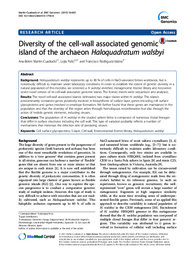Please use this identifier to cite or link to this item:
https://hdl.handle.net/11000/4811
Diversity of the cell-wall associated genomic
island of the archaeon Haloquadratum walsbyi
Title:
Diversity of the cell-wall associated genomic
island of the archaeon Haloquadratum walsbyi |
Authors:
Martín Cuadrado, Ana Belén
Pašić, Lejla
Rodríguez Valera, Francisco |
Department:
Departamentos de la UMH::Producción Vegetal y Microbiología |
Issue Date:
2015-08-13 |
URI:
http://hdl.handle.net/11000/4811 |
Abstract:
Background: Haloquadratum walsbyi represents up to 80 % of cells in NaCl-saturated brines worldwide, but is
notoriously difficult to maintain under laboratory conditions. In order to establish the extent of genetic diversity in a
natural population of this microbe, we screened a H. walsbyi enriched metagenomic fosmid library and recovered
seven novel version of its cell-wall associated genomic island. The fosmid inserts were sequenced and analysed.
Results: The novel cell-wall associated islands delineated two major clades within H. walsbyi. The islands predominantly contained genes putatively involved in biosynthesis of surface layer, genes encoding cell surface glycoproteins and genes involved in envelope formation. We further found that these genes are maintained in the population and that the diversity of this region arises through homologous recombination but also through the action of mobile genetic elements, including viruses.
Conclusions: The population of H. walsbyi in the studied saltern brine is composed of numerous clonal lineages that differ in surface structures including the cell wall. This type of variation probably reflects a number of mechanisms that minimize the infection rate of predating viruses
|
Keywords/Subjects:
Cell surface glycoproteins
S-layer
Cell-wall
Environmental fosmid library
Haloquadratum walsbyi |
Knowledge area:
Microbiología |
Type of document:
application/pdf |
Access rights:
info:eu-repo/semantics/openAccess |
DOI:
https://doi.org/10.1186/s12864-015-1794-8 |
Appears in Collections:
Artículos Producción vegetal y microbiología
|
 ???jsp.display-item.text9???
???jsp.display-item.text9???

.png)
